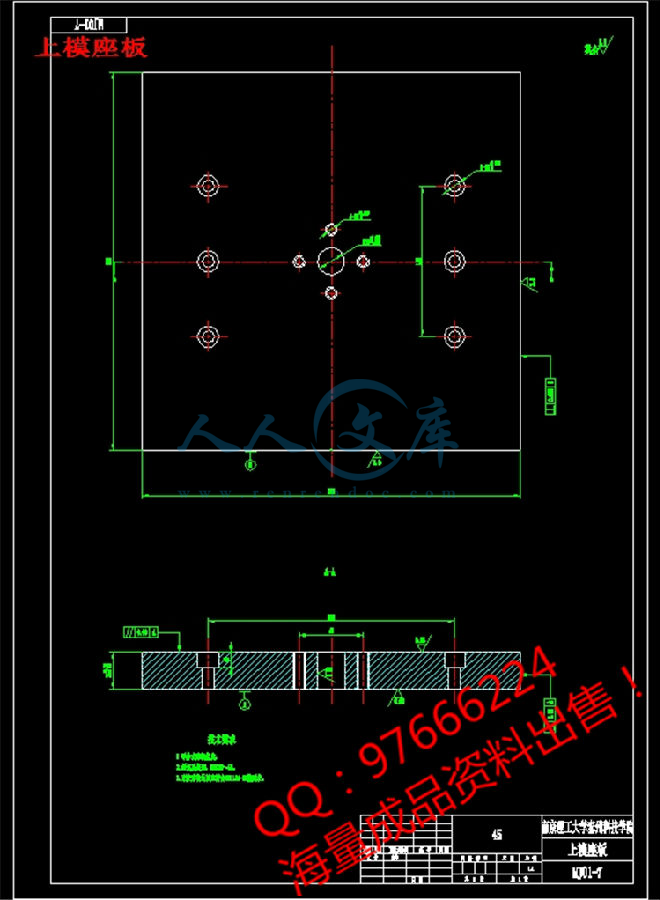!【详情如下】【注塑塑料模具课题】CAD图纸+word设计说明书.doc[14000字,27页]【需要咨询购买全套设计请加QQ97666224】.bat
上模座板.dwg
下模座板.dwg
型芯.dwg
型芯固定板.dwg
垫板.dwg
定位圈.dwg
导套.dwg
导柱.dwg
推杆固定板.dwg
推板.dwg
支撑板.dwg
斜导柱.dwg
浇口套.dwg
滑块.dwg
装配图.dwg
顶杆.dwg
顶板.dwg
三维图
任务书.doc
设计说明书.doc[14000字,27页]
吹风机头选题表.doc
工序卡
开题报告翻译
目录.doc
毕业设计说明书(论文)中文摘要
塑料工业是当今世界上增长最快的工业门类之一,而注塑模具是其中发展较快的种类,因此,研究注塑模具对了解塑料产品的生产过程和提高产品质量有很大意义。本设计介绍了注射成型的基本原理,特别是单分型面注射模具的结构与工作原理,对注塑产品提出了基本的设计原则;详细介绍了冷流道注射模具浇注系统、温度调节系统和顶出系统的设计过程,并对模具强度要求做了说明。该注射模采用了1模1腔侧抽芯的结构。通过本设计,可以对注塑模具有一个初步的认识,注意到设计中的某些细节问题,了解模具结构及工作原理。
关键字 塑料模具 分型面 侧向分型 浇注系统
毕业设计说明书(论文)外文摘要
Title The Development of Mould Industry
Abstract
Plastic industry is in the world grows now one of quickest industry classes, but casts the mold is development quick type, therefore, the research casts the mold to understand the plastic product the production process and improves the product quality to have the very big significance.This design introduced the injection takes shape the basic principle, specially single is divided the profile to inject the mold the structure and the principle of work, to cast the product to propose the basic principle of design; Introduced in detail the cold flow channel injection evil spirit mold pours the system, the temperature control system and goes against the system the design process, and has given the explanation to the mold intensity request. This injection mold used 1 mold 1 cavities sides to pull out the core the structure.Through this design, may to cast the mold to have a preliminary understanding, notes in the design certain detail question, understands the mold structure and the principle of work..
Key word The plastic mold Divides the profile Side core-pulling The pour system
目 录
1 前言 …………………………………………………………………………………1
1.1 模具工业在国民经济中的地位 …………………………………………………1
1.2 各种模具的分类和占有量 ………………………………………………………2
1.3 模具工业现状 ……………………………………………………………………2
1.4 世界五大塑料生产国的产能状况 ………………………………………………4
1.5 我国模具技术的现状及发展趋 …………………………………………………5
2 吹风机头注射成型工艺分析及方案确定 …………………………………………7
2.1 吹风机头注射成型工艺分析 …………………………………………………… 7
2.2 注射成型工艺方案确定 …………………………………………………………8
2.3 主流道设计 ………………………………………………………………………11
2.4 分流道设计 ………………………………………………………………………12
2.5 浇口设计 …………………………………………………………………………13
3 注射成型零部件设计 ……………………………………………………………14
3.1 成型零件的工作尺寸计算 ………………………………………………………14
3.2 成型行腔壁厚计算 ………………………………………………………………15
4 注射模导向及脱模机构设计 ……………………………………………………16
4.1 导向机构设计 ……………………………………………………………………16
4.2 脱模机构设计 ……………………………………………………………………16
5 侧抽芯机构设计 …………………………………………………………………18
5.1 分型抽芯类型确定 ………………………………………………………………18
5.2 侧滑块设计 ………………………………………………………………………18
5.3 滑块定位装置的设计 ……………………………………………………………19
6 模具加工工艺设计 ………………………………………………………………20
6.1 毛坯的确定 ………………………………………………………………………20
6.2 模板平面加工 ……………………………………………………………………20
6.3 孔及孔系加工 ……………………………………………………………………21
7 绘制模具图 ………………………………………………………………………23
7.1 PRO/E创建模具 …………………………………………………………………23
7.2 绘制装配图和部分零件图 ………………………………………………………24
结论 …………………………………………………………………………………25
致谢 ……………………………………………………………………………………26
参考文献 ………………………………………………………………………………27




















 川公网安备: 51019002004831号
川公网安备: 51019002004831号